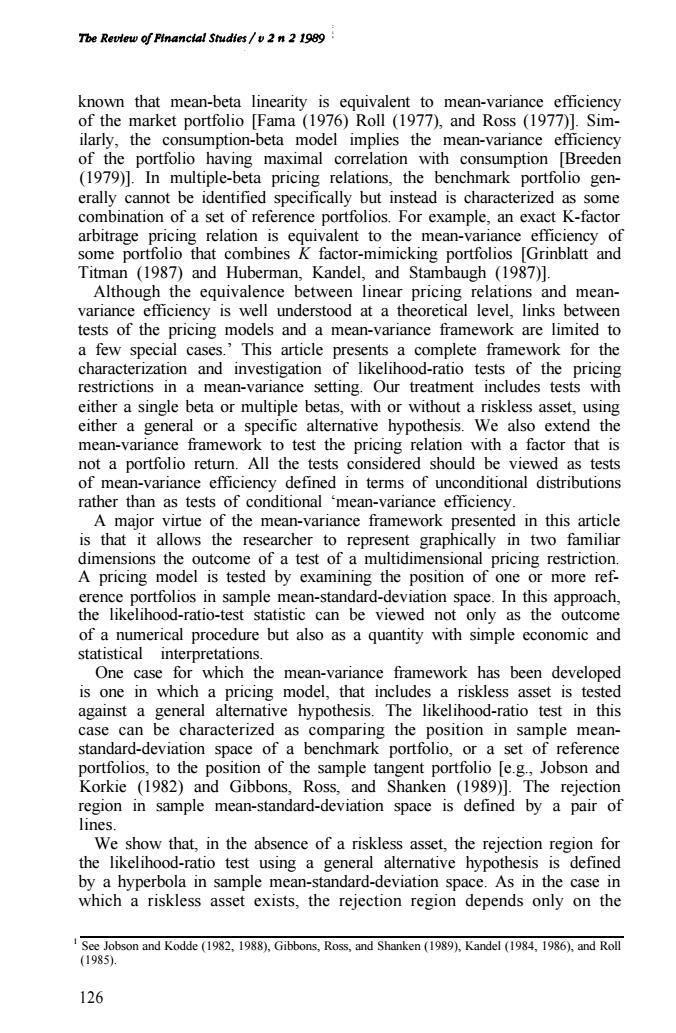正在加载图片...

Tbe Revlew of Financial Studies /v 2n 2 1989 known that mean-beta linearity is equivalent to mean-variance efficiency of the market portfolio [Fama (1976)Roll (1977),and Ross (1977)].Sim- ilarly,the consumption-beta model implies the mean-variance efficiency of the portfolio having maximal correlation with consumption [Breeden (1979)].In multiple-beta pricing relations,the benchmark portfolio gen- erally cannot be identified specifically but instead is characterized as some combination of a set of reference portfolios.For example,an exact K-factor arbitrage pricing relation is equivalent to the mean-variance efficiency of some portfolio that combines K factor-mimicking portfolios [Grinblatt and Titman (1987)and Huberman,Kandel,and Stambaugh (1987)]. Although the equivalence between linear pricing relations and mean- variance efficiency is well understood at a theoretical level,links between tests of the pricing models and a mean-variance framework are limited to a few special cases.'This article presents a complete framework for the characterization and investigation of likelihood-ratio tests of the pricing restrictions in a mean-variance setting.Our treatment includes tests with either a single beta or multiple betas,with or without a riskless asset,using either a general or a specific alternative hypothesis.We also extend the mean-variance framework to test the pricing relation with a factor that is not a portfolio return.All the tests considered should be viewed as tests of mean-variance efficiency defined in terms of unconditional distributions rather than as tests of conditional mean-variance efficiency. A major virtue of the mean-variance framework presented in this article is that it allows the researcher to represent graphically in two familiar dimensions the outcome of a test of a multidimensional pricing restriction. A pricing model is tested by examining the position of one or more ref- erence portfolios in sample mean-standard-deviation space.In this approach, the likelihood-ratio-test statistic can be viewed not only as the outcome of a numerical procedure but also as a quantity with simple economic and statistical interpretations. One case for which the mean-variance framework has been developed is one in which a pricing model,that includes a riskless asset is tested against a general alternative hypothesis.The likelihood-ratio test in this case can be characterized as comparing the position in sample mean- standard-deviation space of a benchmark portfolio,or a set of reference portfolios,to the position of the sample tangent portfolio [e.g.,Jobson and Korkie (1982)and Gibbons,Ross,and Shanken (1989)].The rejection region in sample mean-standard-deviation space is defined by a pair of lines. We show that,in the absence of a riskless asset,the rejection region for the likelihood-ratio test using a general alternative hypothesis is defined by a hyperbola in sample mean-standard-deviation space.As in the case in which a riskless asset exists,the rejection region depends only on the See Jobson and Kodde(1982,1988),Gibbons,Ross,and Shanken (1989),Kandel (1984,1986),and Roll (1985). 126known that mean-beta linearity is equivalent to mean-variance efficiency of the market portfolio [Fama (1976) Roll (1977), and Ross (1977)]. Similarly, the consumption-beta model implies the mean-variance efficiency of the portfolio having maximal correlation with consumption [Breeden (1979)]. In multiple-beta pricing relations, the benchmark portfolio generally cannot be identified specifically but instead is characterized as some combination of a set of reference portfolios. For example, an exact K-factor arbitrage pricing relation is equivalent to the mean-variance efficiency of some portfolio that combines K factor-mimicking portfolios [Grinblatt and Titman (1987) and Huberman, Kandel, and Stambaugh (1987)]. Although the equivalence between linear pricing relations and meanvariance efficiency is well understood at a theoretical level, links between tests of the pricing models and a mean-variance framework are limited to a few special cases.’ This article presents a complete framework for the characterization and investigation of likelihood-ratio tests of the pricing restrictions in a mean-variance setting. Our treatment includes tests with either a single beta or multiple betas, with or without a riskless asset, using either a general or a specific alternative hypothesis. We also extend the mean-variance framework to test the pricing relation with a factor that is not a portfolio return. All the tests considered should be viewed as tests of mean-variance efficiency defined in terms of unconditional distributions rather than as tests of conditional ‘mean-variance efficiency. A major virtue of the mean-variance framework presented in this article is that it allows the researcher to represent graphically in two familiar dimensions the outcome of a test of a multidimensional pricing restriction. A pricing model is tested by examining the position of one or more reference portfolios in sample mean-standard-deviation space. In this approach, the likelihood-ratio-test statistic can be viewed not only as the outcome of a numerical procedure but also as a quantity with simple economic and statistical interpretations. One case for which the mean-variance framework has been developed is one in which a pricing model, that includes a riskless asset is tested against a general alternative hypothesis. The likelihood-ratio test in this case can be characterized as comparing the position in sample meanstandard-deviation space of a benchmark portfolio, or a set of reference portfolios, to the position of the sample tangent portfolio [e.g., Jobson and Korkie (1982) and Gibbons, Ross, and Shanken (1989)]. The rejection region in sample mean-standard-deviation space is defined by a pair of lines. We show that, in the absence of a riskless asset, the rejection region for the likelihood-ratio test using a general alternative hypothesis is defined by a hyperbola in sample mean-standard-deviation space. As in the case in which a riskless asset exists, the rejection region depends only on the 1 See Jobson and Kodde (1982, 1988), Gibbons, Ross, and Shanken (1989), Kandel (1984, 1986), and Roll (1985). 126